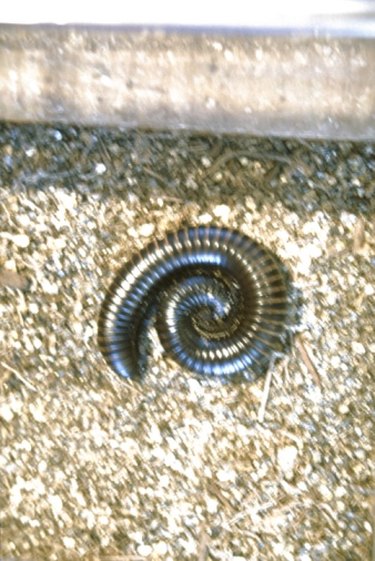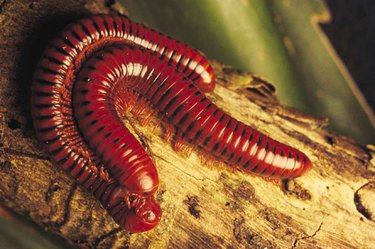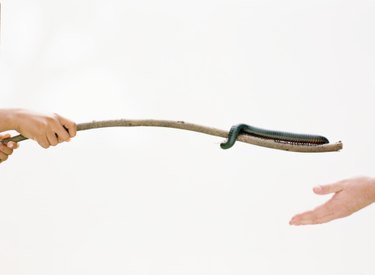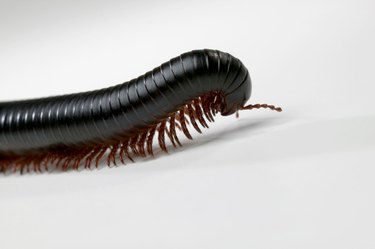
There have been more than 1,200 species of millipedes studied, and many of them reside in the southeastern United States. They live in wooded areas, hiding under debris of all kinds. Occasionally, they are found in homes, most often being seen in showers, sinks and bathtubs. Alabama has its share of this fairly harmless and ecologically important class of land invertebrate.
Description
Video of the Day

Millipedes, class Diplopoda, have two pairs of legs at each of their body segments, separating them from centipedes, which only have one pair. Like centipedes, they are not insects but a class all to themselves. Millipede bodies resemble worms in appearance, except for their multitude of legs, and they have a pair of short antennae on their heads. Some people call millipedes "thousand leggers," but this is not the case. Millipedes of different genera come in different colors. Many are black or gray but some have brilliant orange-red or yellow and black stripes. Two members of the order Polydesmida, family Xystodesmidea were photographed in 2009; one of the species Ampheloria virginiensis, had yellow margins on each black segment, and the other of the species Bracheria/sigmoria, had reddish lateral margins on each segment. Both were located in northern Alabama.
Video of the Day
Harmful Aspects

Millipedes do not sting or bite, and children find them interesting, often picking them up to play with. Some brightly-colored species of millipede secrete cyanide. In 2010, a homeowner in Chilton county, Alabama found several species of Pachydesmus millipedes in his basement. They all had pale yellow and dark brown colored segments and pale legs and emitted an almond-scented secretion when disturbed. This scent implies the presence of cyanide. Others, when threatened, secrete a foul-smelling, brown-staining substance that can irritate the skin. Do not allow children to handle these fascinating, but potentially noxious, creatures. Whenever a millipede is handled, it is prudent to immediately wash the skin it has touched. If burning, redness or irritation occurs after coming in contact with a millipede, or other symptoms are experienced, you should call your local poison control center for specific instructions.
Feeding and Growth Habits

Millipedes are usually vegetarians who feed on dead and dying flora. The rare species are carnivorous, however, others feed on living vegetation. Millipedes lay eggs, but do not go through a larval stage. Millipedes molt instead, like spiders and crabs, and grow more segments and legs with each molting. These invertebrates are known to live as long as 10 years. Commonest all over the southern U.S. is the Narceus species of millipede. These creatures come in solid colors ranging from brown to black, are small (2 to 4 inches long) and wormlike, with tiny legs and short antennae.
Ecological Importance

Millipedes are an ancient class of animal. There may be more than 80,000 different species living today. They have been poorly studied and their frequented habitat areas are not well-documented. Millipedes are the third most diverse class of earth's arthropods and, ecologically, are of great significance. As stated by the National Science Foundation in cooperation with PEET (Partnership for Enhancing Expertise in Taxonomy), "Millipedes are of outstanding ecological importance and play a crucial role in the decomposition of leaf litter and in the nutrient cycle within the soil."
- TruTech: Centipede - Millipede Pest Control Services
- Bug Guide; Iowa State University, 2003-2011.
- Alabama Poison Center; Poison Hazards; Scorpions, Ticks, Catipillars, Centipedes and Millipedes; March 16, 2011.
- Bug Guide; Iowa State University; Comparison of Two Species of Millipede in No. Alabama - Apheloria Virginiensis
- Bug Guide: Pachydesmus